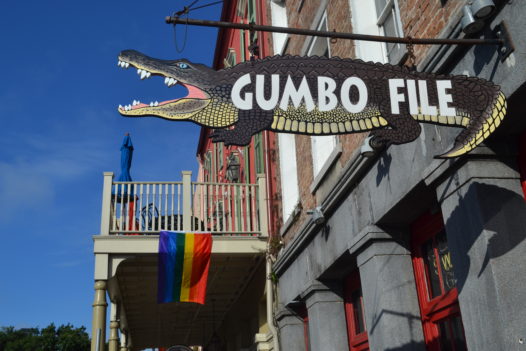
Gumbo File by Mystic Blue Signs (photo by: Sarah Holtz)
Like many centuries-old U.S. cities, New Orleans has a long history of hand lettering. This past manifests itself most prominently in hand-painted “ghost signs” fading on the sides of brick buildings from the French Quarter to the Lower Garden District. Hand-painted signs were a predominant method of advertising—until the emergence of digitally produced signage precipitated the trade’s decline in the 1980s and 1990s.
This was the state of hand lettering when Yvette Rutledge arrived in New Orleans in 1995. Armed with years of practice in the arts of sign painting, typography, calligraphy, and graphic design, she freelanced in the city for two years. Finding enough work to sustain business, in 1997 she founded Mystic Blue Signs, a small shop and sign-painting studio, on Magazine Street.
“It was a gamble,” Rutledge says, “but we felt if we hung out a shingle and said, ‘Hand Painted Signs’ that either people would get it or they wouldn’t. And Magazine Street had a lot of traffic, so we thought it would be a good location for it. And it turned out to be that way.”
Along with her partner Vince Mitchell, Rutledge is one of a handful of hand-lettered sign makers in New Orleans. Since opening Mystic Blue Signs in 1997, the studio has established a notable presence on the city’s aesthetic. Take a stroll in the French Quarter or down Magazine Street and you’ll find many examples of Mystic Blue’s sign-artistry on display on almost every block.
In addition to the signs themselves, Rutledge and Mitchell have created a presence in the community as teachers, providing a space for a new generation of sign makers to learn the craft of hand lettering. Through the Center for the Lettering Arts, established in 2010, Rutledge offers classes and workshops designed to encourage the use of hand lettering as an expressive art.
“It seems as though there’s much more interest in hand lettering in general than there used to be 30 years ago,” Rutledge says. “Because the computer generation—the kids that grew up with computers—they really get it. They get computers. But there’s also the other side of it. That the tactile approach of making something by hand is gaining more appreciation. In the same way that you can say that things like craft beers and organic vegetables. Because you see the touch of the human hand. You see the human expression in it.”
Students of all stripes have signed up for the workshops. Some continuing their education in graphic design, others simply wanting the ability to design their own wedding invitations.
“I haven’t had any students say, ‘I really don’t like doing this—it’s not for me,'” Rutledge says. “They find their own niche. Because the alphabet belongs to everybody—cause we all grew up writing—somehow that seems natural. It should be an expressive form. And people should find their own means of expression.”
To learn more about Mystic Blue Signs and see samples of their work, visit their website at www.mysticbluesigns.com.
 NOLAbeings Multimedia artist Claire Bangser created NOLAbeings as a portrait-based story project that marries...
NOLAbeings Multimedia artist Claire Bangser created NOLAbeings as a portrait-based story project that marries...  Voodoo in New Orleans: Reviving history: New Orleans fortune telling This article takes a deep dive into the history of Voodoo in New Orleans, its hybridization with Catholicism, and its present-day place in the city's culture. The author visits fortune-tellers in the French Quarter, using their guidance as a tool for introspection rather than a deterministic predictor of the future. Through her experiences in New Orleans, the author feels a mystical connection to both the past and the future.
Voodoo in New Orleans: Reviving history: New Orleans fortune telling This article takes a deep dive into the history of Voodoo in New Orleans, its hybridization with Catholicism, and its present-day place in the city's culture. The author visits fortune-tellers in the French Quarter, using their guidance as a tool for introspection rather than a deterministic predictor of the future. Through her experiences in New Orleans, the author feels a mystical connection to both the past and the future. 